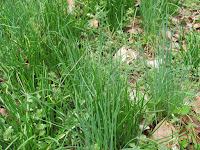 |
| Wild Garlic - spring weed |
 |
| Dandelion |
Avoid spraying on windy days or on hot
days over 85 °F as chemical herbicides can drift or volatilize, injuring nearby garden
plants. Warm summer temperatures increase the possibility of lawn injury from certain herbicides. It should not rain within 24 hours after application. Don't mow a few
days before and 2-3 days following an application. Wait 3-4 mowings before
treating a newly seeded lawn with any herbicide.
There may be 3 different kinds of weeds you’re trying
to control: grasses, broadleaf types and sedges. Broadleaf weeds include
dandelions, spotted spurges, buckthorns, purslanes and thistles. Fall and late
winter (before new leaves emerge) are safe times to spray broadleaf herbicides.
Most deciduous shrubs and trees are shedding their leaves and are less
susceptible to the spray drift.
Spring and early summer herbicide
applications will not control perennial and woody vegetation such as brambles
or poison ivy. Wait until mid-summer to tackle these tough weeds.
For a contact broadleaf herbicide to work, outdoor temperatures need to be 60 °F and higher over a 6 hour interval for the spray to be absorbed into the plant. Regardless the time
of the year, weeds need to be actively growing for herbicides to work.
Finally, heavy weed invasion in
lawns may be evidence of poor mowing practices, low soil fertility, or too much
shade. Knotweed and spotted surge
may indicate bad soil compaction. Tough weeds are not going to give up easily
and multiple applications. may be necessary.
Always read and understand the package directions before using.

